Bleeding brakes on airplanes seems to be a challenging and often frustrating task. I’ve easily bled numerous car brakes with a helper, with no tools other than a jar, a short piece of hose, and a wrench for the bleed screw. This is likely because in a car, the single master cylinder and reservoir are co-located at the highest point in the system.
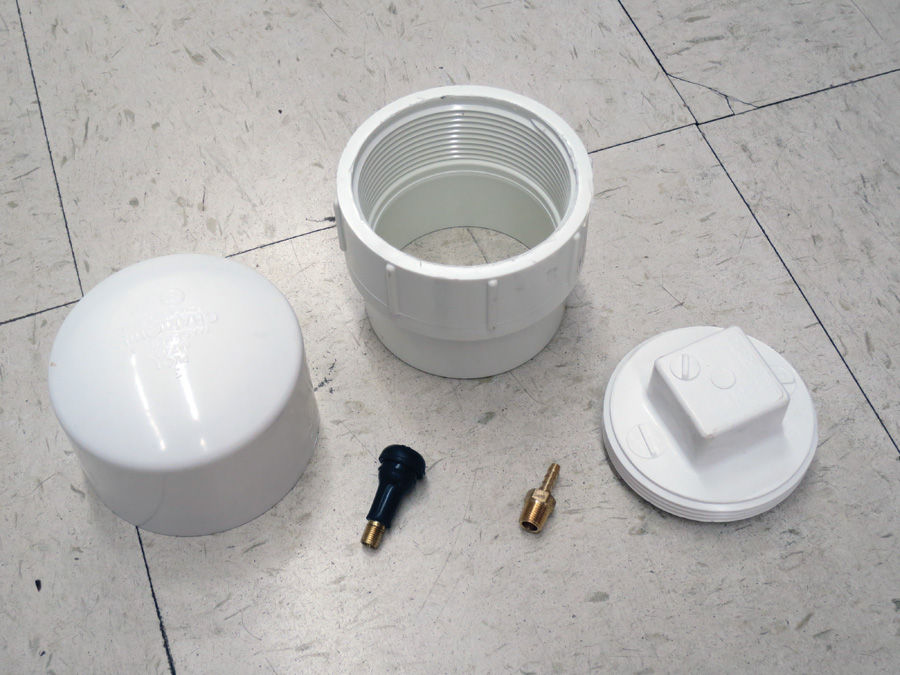
Main components from the hardware store: 3-inch PVC end cap, clean-out adapter and screw-in end cap, tire Schrader valve, and 1/8-inch pipe male to 1/8-inch barbed brass fitting.
Not so in most small airplanes, not to mention line routing that is up and down, and serially connected master cylinders from pilot to copilot side, giving rise to many more opportunities for trapped air. Having bled my Wheeler Express Cleveland brakes and master cylinders several times, I have to admit it has been very difficult to achieve nice solid brakes. Somehow a small amount of air always seems to remain trapped in the system.
I’ve used car bleed techniques with a helper, pumping the brakes repetitively, endlessly circulating the fluid around in a circle from bleeder to reservoir by pumping the brakes, using vacuum on the master cylinder, etc., and nothing seemed to work perfectly. This time, I decided to research the topic more thoroughly, but unfortunately everyone has their pet ideas, and there are an endless number of bleeder products out there, making it somewhat unclear as to what really works best.
After reading the very helpful and extensive discussions at VAF (VansAirForce.net), I came to the following conclusions:
- Bleeding upward rather than downward is preferable, as it is much easier to get air to travel upward with the fluid.
- While a vacuum approach (sucking fluid into/through the system) may seem attractive, because theoretically vacuum expands trapped air, pushing it up and out the reservoir, it has a downside: Any place the system is not perfectly sealed, air can get drawn in, especially at the bleeder threads.
- The master cylinders in uncompressed state have valves open and will let fluid pass in both directions—a helpful situation for pressure bleeding.
- Upward pressurized flow is the best way to clear the system of air. A little bit of leakage at the bleeder threads is tolerable collateral damage. The higher the flow rate, the better to dislodge little bubbles.
- Tapping on calipers and master cylinders during the process can further help dislodge any small air bubbles.
The PVC Pipe Pressure Bleeder
One of the VAF posts suggested a homemade PVC pipe pressure bleeder, so I came up with what’s pictured. It’s really simple: A 3-inch PVC clean-out adapter, an end cap, and the adapter screw-in cap. Drill and tap the end cap at its center for 1/8-inch pipe thread, and install a hardware store 1/8-inch pipe male to 1/8-inch barbed brass fitting. In the top screw-in cap, I drilled a hole and pressed in a tire Schrader valve, sealed with a bit of silicone rubber. Add a length of 1/4-inch Tygon tubing to the bottom fitting, and you are set to go. I added three legs cut as strips from a piece of 3-inch PVC—when my wife looked at the finished product, she laughed and said it looked like R2-D2!
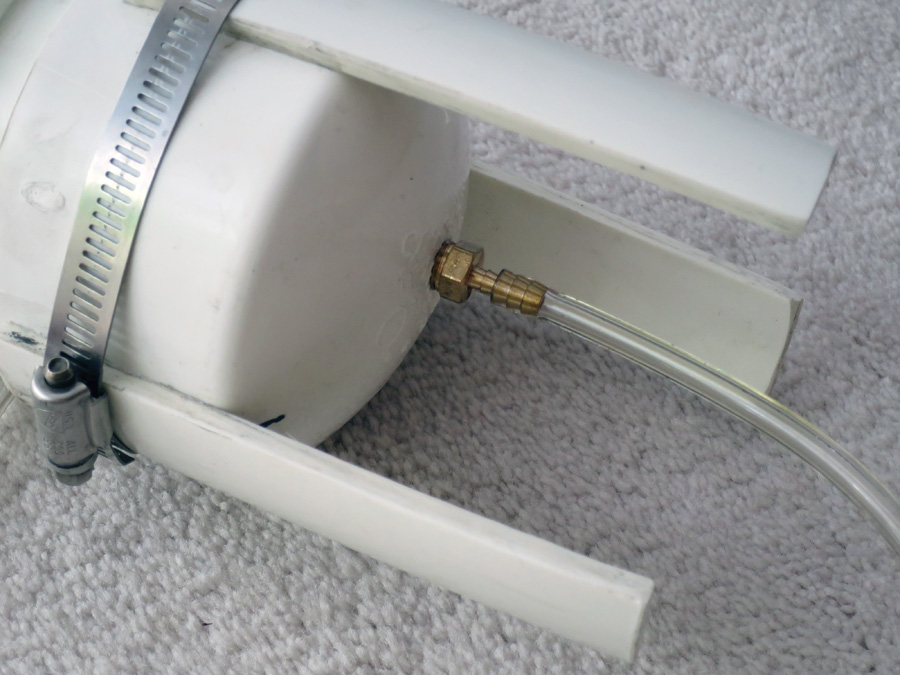
Barbed brass fitting installed in the bottom of the bleeder. Attached to the fitting is 1/4-inch Tygon tubing.
Using It
Partially fill the bleeder with brake fluid. Crack the bleeder screw to turn and attach the hose. If you are working on a system that already has fluid in it, lower the hose enough to get fluid to flow to the end of the hose, and simultaneously crack the bleeder screw on the bottom of one brake caliper. Then attach the hose to the bleeder as some fluid leaks out of the caliper. With care this can be done without introducing any air bubbles during the attachment. It’s a little messy, but that’s what paper towels and rubber gloves are for.

The finished product. Note the Schrader valve attached to the screw-in cap. Strips from a piece of 3-inch PVC pipe were used to make the legs.
I found Tygon tubing would fit and stay on the bleeder all by itself. It works much better than polyethylene tubing, which may tend to crack when pressed onto the bleeder screw. Some have used safety wire to help secure it. In any case, it is probably a good idea to shield the rest of the brake assembly with some plastic sheet, just in case the hose leaks or lets go. Cleaning oil off the rotor or brake pads can be a huge and undesirable setback!
Next, apply pressure from a compressor or bicycle pump via the Schrader valve. I use 20-30 psi and watch the fluid go in and up the system. The screw-in cap will leak some air, but the compressor can easily keep up with it, and the pressure loss when input air is disconnected conveniently stops the flow. Periodically check the reservoir to keep it from overflowing. A turkey baster works well for keeping the level in check. I alternated between one wheel and then the other two times, closing the bleeder valves in between. In less than half an hour, I was able to achieve nicely solid brakes. It was the first time I was able to bleed the brakes so quickly.










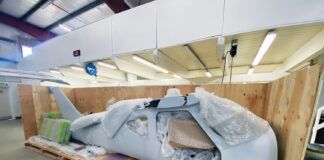
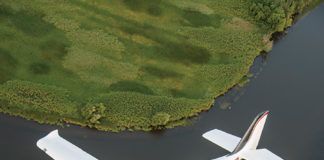
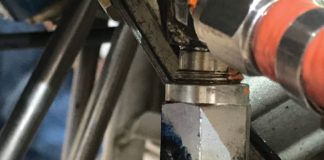
Thanks for providing a link for making R2-D2. Simple and easy tool to make bleeding brakes a one person endeavor if needed. I use DOT #5 in my Buell already so I have it on hand.
Danke again